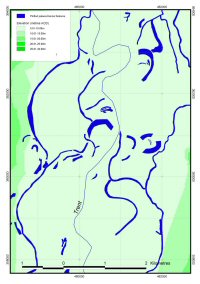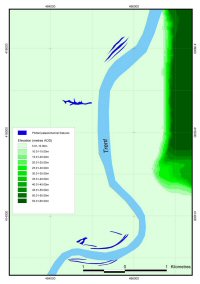
The upland zone of the Trent is typical of an upland high-energy river system (Howard and Macklin 1999) where several factors may inhibit the long-term preservation of palaeochannels. Although river channel change is ongoing and often vigorous, high-magnitude flood events are likely to flush sediment fills from the narrow valley floor repeatedly, thus preventing long-term terrace preservation. In addition, incision may result in reworking and a falling water table, causing dewatering of organic deposits (ibid., 529). This model suggests that large-scale preservation of palaeochannel deposits is unlikely in the upland zone, a prediction borne out by the results of the Trent Valley survey where few channels were recorded upstream from Rugeley, Staffordshire, and none beyond Weston (Figure 7).

Downstream from Rugeley, the Middle Trent Valley begins to develop, still clearly defined by valley side slopes, but with gravel terrace units now increasingly preserved within a broader floodplain, typically 1–3 kilometres wide. Howard and Macklin (1999, 534) note the potential for preservation of longer archaeological and palaeoenvironmental records in this type of medium-energy system, and in particular the likely survival of organic material in palaeochannels. The Trent Valley survey demonstrates this potential, with hundreds of surface-visible channels recorded from this part of the valley.

Within the Middle Trent, there are differences of emphasis in the surface-visible palaeochannel record, and in the geomorphology of the valley. Gravel terrace units dominate (roughly 60% by area) in the upper part of the middle valley (approximately Rugeley to Nottingham; Figure 8), and this pattern focuses on a number of confluences with major tributaries draining upland areas (the Tame, Dove, Derwent and Soar). The inputs from these high-energy tributaries have led to the formation of broad confluence zones, with the valley enlarged to a width of up to 6 kilometres and dominated by extensive gravel terraces. The river is extremely mobile in these confluence zones, with lateral movement of the main channel in the region of 200 metres since 1800 (Large and Petts 1996). Consequently these zones are extremely rich in surface-visible palaeochannels (an average density of 3.2 channels/km² in the upper middle valley as a whole), suggesting rapid, varied and ongoing channel movement with a large number of relatively narrow channels. Although this landscape is dynamic, there is potential for the survival of older channels, e.g. at Hemington, Leicestershire, where channels associated with the Trent/Soar confluence were dated from the 8th century AD onwards (Ellis and Brown 1998). It should be noted that non-surface-visible channels are also present: gravel fills in gravel channels were recorded at Hemington (Cooper 2003). Away from the confluence zones, stretches of the upper middle river appear to have been more stable, with a single meandering channel developing in the post-medieval period (Large and Petts 1996). In these reaches the surface-visible record is less varied, in general suggesting processes of anastomosis and meander with little evidence for braiding. The multiple channel form in many reaches appears to reflect an anastomosing river prone to episodes of avulsion. Channels manifesting as cropmarks form the largest group in all parts of the valley, but in the upper middle valley this group is at its lowest proportion (50–60% of surface-visible features). The significant representation of dry depressions within floodplain grassland (around 30%) reflects the survival of a significant area of floodplain pasture, at least until the 1970s. The mobility of the river, and the non-cohesive channel banks may explain the persistence of this non-arable buffer around the channel-movement zone.

The lower part of the Middle Trent Valley (Figure 9), from Nottingham downstream as far as Gainsborough, Lincolnshire, begins to be dominated by units of fine-grained alluvium (around 60% by area), although significant gravel-terrace units (about 30%) are still present. The modern river is a relatively stable, single, meandering channel (except for an artificial anabranched reach at Newark, Nottinghamshire) in a broadening floodplain (typically 2–5 kilometres wide). The presence of arable cultivation right up to the channel margins, increasing downstream, is reflected in a higher proportion of cropmark features in the surface-visible record (70% compared to 10–20% dry depressions). There are fewer recorded palaeochannel features in the lower middle valley (an average density of 1.7 channels/km²); however, these channels are in general broader and longer than those in the upper middle valley, and cover a greater percentage area (3.4% of the survey area compared to 3.2%). When compared to the continually shifting confluence zones upstream, therefore, the record in this part of the valley appears to reflect periods of channel stability interrupted by a smaller number of major channel-shifting events (anabranching, avulsion, meander cut-off), perhaps in the context of high-energy episodes like those attested at Langford, Nottinghamshire (Howard et al. 1999; Lillie and Grattan 1995).

The lower or perimarine valley (Figure 10) below Gainsborough is dominated by the vertical accretion of extremely thick deposits of fine-grained alluvium overlying earlier units, with increased lateral stability of the channel banks (Howard and Macklin 1999). This massive amount of sedimentation is linked both to human activity, such as deforestation (Lillie and Grattan 1995) and warping to increase soil fertility via overbank deposition (Large and Petts 1996), and to sea-level change during the Holocene (Lillie and Grattan 1995). Very few surface-visible palaeochannels were recorded here (an average density of 0.2 channels/km²); this reflects the masking effect of thick sequences of alluvium and confirms the need for complementary methodologies to map sub-surface topography in such areas, including the analysis of borehole records (Lillie 1998a; 1998b), geophysical prospection (Brown and Keogh 1992; Bates and Bates 2000) and digital surface-extrapolation methods (Challis and Howard 2003).